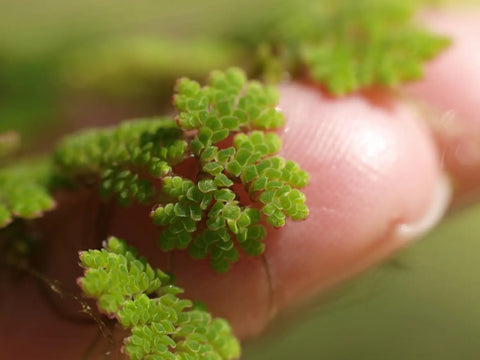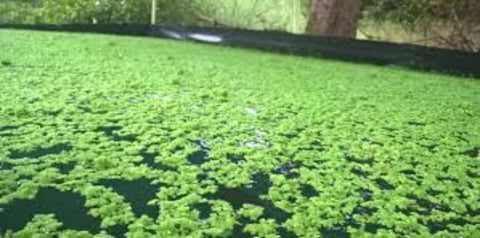Azolla’s life-cycle. A unique biological system for Livestock Feed
The Azolla Superorganism: A unique biological system
The Azolla Superorganism
The azolla-anabaena symbiosis has been called a superorganism that combines the individual talents of two very different organisms. The cyanobacterium anabaena evolved during the early history of the Earth more than three billion years ago when the planet’s atmosphere was devoid of oxygen. The other organism is the fern azolla.
Azolla’s floating leaves contain cavities that provide a microenvironment for anabaena which draws down up to 1000 kg of atmospheric nitrogen per acre per year. The nitrogen provides a natural fertilizer for azolla’s growth, freeing the plant from its reliance on soil and enabling it to grow free-floating on freshwater bodies

The azolla-anabaena superorganism is unique. We know of no other symbiotic relationship in which a cyanobacterium and plant pass down together during reproduction from generation to generation. A few other plants have a symbiotic relationship with cyanobacteria, including some cycads and the anthophyte Gunnera, but the relationship has to be renewed each generation; it is broken after the plant dies and new cyanobacteria must re-colonize the plants in order to continue the relationship.
In contrast, azolla and anabaena are never apart; they have not been separated for almost a hundred million of years. They have evolved together continuously during this immense period of time as the Earth’s climate changed from a greenhouse world to the present phase of glacial-interglacial cycles.
Azolla’s morphology is unlike that of other ferns and, in particular, its leaf structure has evolved to provide an environment that is ideal for anabaena. Azolla’s life cycle also makes it possible for anabaena to pass uninterrupted from one generation of azolla to the next. This has enabled the two organisms to evolve continuously together for 80 million years, a relationship unknown elsewhere on the planet.
Azolla’s leaves occur in two rows along each side of the plant’s stem. Each leaf has a very thin ventral lobe and a thick, greenish or reddish photosynthetic dorsal lobe containing a cavity that is the key to the azolla and anabaena symbiosis.

The centre of the cavity is filled with a gas or liquid and the bacteria are immobilized in the peripheral area of the cavity by a mucilaginous fibrillar network (Carrapiço 1991, 2002, 2010).
Azolla’s leaf cavities provide an ideal micro-environment for the heterocyst-forming nitrogen-fixing filamentous bacterium Anabaena azollae.
This is the key to azolla’s ability to sequester enormous amounts of atmospheric CO2.
Azolla’s life-cycle
Unlike plant-cyanobacterial symbioses in vascular plants, the azolla-anabaena symbiotic system is sustained throughout the fern’s life cycle, where the cyanobacterium and bacteria are always present (Carrapiço, 2010), either in the dorsal lobe leaf cavities or in the sexual structures (sporocarps) (Carrapiço, 1991, 2002). The azolla plants are never infected de novo, since anabaena is transferred between generations as akinete inocula (Carrapiço, 2010). This maintains continuity of the symbiosis during sexual reproduction, summarized in Peters & Meeks (1989). During azolla’s sporulation, filaments of anabaena are packaged into the developing sporocarps. As sporocarp gender is determined later in azolla’s development, anabaena is present in both the megasporocarps and microsporocarps, but anabaena is only maintained by the megasporocarps, thus maintaining the symbiotic continuity.
Notes on Natural Enemies
Host records from around the globe show that the genus Azolla is attacked by generalist herbivores and that very few specialist insect species have evolved on these plants (Hill, 1997). However, four beetle species, the weevils Stenopelmus rufinasus and S. brunneus and the two flea beetles Pseudolampsis guttata and P. darwinii, appear to have specialised on the genus Azolla (Richerson and Grigarick, 1967; Habeck, 1979; Hill, 1999) and were identified as potential biological control agents for A. filiculoides in South Africa (Hill, 1997). Following host range testing,Stenopelmus rufinasus was released in 1997 as a biocontrol of A. filiculoides in South Africa (McConnachie et al., 2004).
Other bacterial symbionts
Azolla’s leaf cavity provides an ideal micro-environment for a bacterial community that includes various strains of the genera Anthrobacter, Corynobacterium and Agrobacterium plus the heterocyst-forming nitrogen-fixing filamentous bacterium Anabaena azollae.
Other bacteria are present in azolla’s leaf cavities and include Arthrobacter which commonly occurs in soils. Like anabaena, these bacteria also occur throughout azolla’s life cycle and have a developmental pattern that is identical to that of anabaena (Forni et al., 1990; Van Hove, 1989; Carrapiço, 1991). Their role in the symbiosis is not yet fully understood, but the present data indicate that anabaena is the only bacterial symbiont of azolla that fixes nitrogen.
The free-living species Arthrobacter chlorophenolicus is capable of degrading high concentrations of 4-chlorophenol, indicating its potential use for bioremediation (Westerberg et al., 2000).
